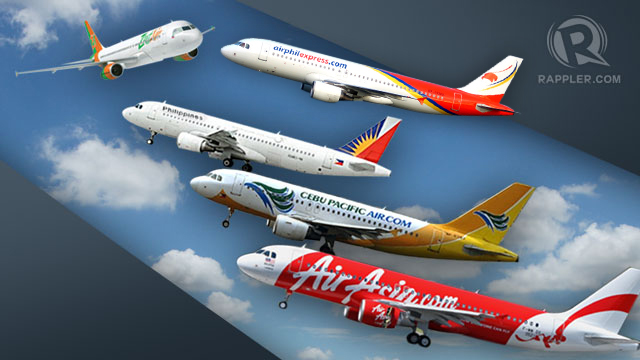SUMMARY
This is AI generated summarization, which may have errors. For context, always refer to the full article.

MANILA, Philippines – The Philippine local domestic airline industry has the highest penetration rate of budget carriers in Southeast Asia, an aviation think tank said.
Budget or low-cost carriers (LCC) account for 67% of the total domestic market, according to the latest report of Centre for Asia Pacific Aviation (CAPA).
This is higher than the Philippines’ 60% local LCC penetration rate the aviation think tank had noted in 2012.
It cited the increased capacities and more destinations of local budget airline players Cebu Pacific, Zest Air, Tiger Airways Philippines and Philippines’ AirAsia.
INFOGRAPIC: How Philippine budget airlines change the game
READ: Budget airlines rule Philippine skies
Flying to and from local destinations is ideal in the Philippines, an archipelago of over 7,100 islands. Promotional fares help grow the market and encourage travelers who used to take buses or ferries to take the more convenient and faster air transport option.
READ: 6 rights you have as an airline passenger
Budget airlines in the Philippines and other markets have boosted the orders for fuel-efficient aircraft from global makers Boeing and Airbus, as well as dictated the airport infrastructure designs in various destinations.
International market
In the global market, the Philippines ranks 4th with a 29% international LCC penetration rate, CAPA added.
This marginally smaller global rate will increase significantly “as the Philippines-Japan market has just opened up to expansion from Philippine carriers, ending 5 years of restriction,” it added.
READ: Finally, Japan allows Philippines to increase direct flights
Overall, the Philippines’ system-wide LCC penetration rate stood at 51%, second to Indonesia’s.
Below are CAPA’s estimates of total — domestic and international — penetration rates of LCCs in the region:
- Indonesia – 56%
- Philippines – 51%
- Malaysia – 50%
- Singapore – 31%
- Thailand – 30%
- Vietnam – 24%
- Myanmar – 16%
- Brunei – 16%
- Cambodia – 12%
- Lao PDR – 5%
The aviation think tank said LCCs now account for over 50% of capacity in Southeast Asia’s 4 largest domestic markets: Indonesia, Malaysia, Philippines and Thailand.
“Southeast Asia remains a dynamic and fast-growing market. Competition is as fierce as it has ever been and will only intensify as several new carriers, primarily LCCs, plan to enter the market over the next year. But overall the outlook for the Southeast Asian market is bright.”
Moreover, CAPA noted that LCCs have been able to rapidly claim about a 50% share in the intra-Southeast Asia international market.
Aircraft orders
CAPA said that LCCs will soon account for one-third of Southeast Asia’s fleet by early 2014.
Based on aircraft fleet growth, CAPA said the total Southeast Asia-based LCC will grow by about 20% in 2013, reaching nearly 500 aircraft by end of this year.
Cebu Pacific’s fleet at end-2012 stood at 41. This is seen to increase to 48 by end of this year. Gokongwei-led carrier’s fleet growth ranked 3rd among all Southeast Asian LCC.
“Southeast Asia continues to post some of the highest growth rates in the global aviation industry, driven primarily by expansion in the region’s booming low-cost sector,” said CAPA.
What about legacy carriers?
Bucking the trend, former budget carrier PAL Express, previously called Airphil Express and a unit of legacy carrier Philippine Airlines (PAL), transitioned to full-service carrier in early 2013.
PAL ranked 6th in terms of seat capacity, fleet size and home market share among full-service carriers or legacy airlines in the region.
CAPA said legacy carriers like PAL will continue to have an important role in the Southeast Asian market, both on long-haul routes and regionally.
The region’s flag carriers currently provide about 3 million weekly seats, giving them about 35% share of the market.
“Most of Southeast Asia’s flag carriers have been able to retain significant shares of their home market and remain profitable. On average they have also continued to grow faster than their counterparts in other regions,” CAPA noted.
“But there has also been growth in 2013 at nearly all of the region’s flag carriers. A large portion of this growth has been on regional routes as full-service operators have been able to join the LCCs in taking advantage of the generally favorable economic conditions in Southeast Asia,” it said. – Rappler.com
Add a comment
How does this make you feel?
There are no comments yet. Add your comment to start the conversation.